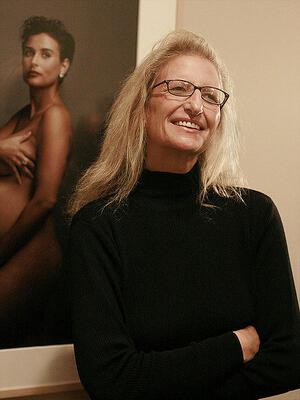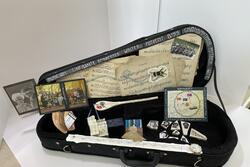The Jewess Behind the Camera
Annie Leibovitz is one of the most famous and renowned photographers alive today. She is pictured here with her photograph "More Demi Moore," the August 1991 Vanity Fair front cover, a nude photograph of the then seven-months pregnant Demi Moore.
Photo by Marc Silber of www.silberstudios.com.
As a history nerd, I can cite dozens of examples when a single photograph changed the course of events.
However, I did not understand the visceral reaction that a photo could evoke until my junior year of high school, when I took a class in graphic design. Learning to use photo manipulation programs like Photoshop to create artistic projects gave me a new perspective on photography, allowing me to understand it as the powerful art form that it is.
Since I am a woman of the Tribe, my newfound interest in photography compelled me to see if I was the only Jewess interested in the camera.
Unsurprisingly, many Jewish women have excelled in the field of photography. One such person is Diane Arbus. She and her husband worked together in commercial and fashion photography before she got involved in photojournalism in the 1950s. Her work was quickly noticed by the art world, and she was awarded a prestigious Guggenheim fellowship to develop her craft. Arbus’s photographs were revolutionary, forcing society to acknowledge the existence of marginalized and unusual people. One of Arbus’s most famous photographs, "A Young Brooklyn Family Going for a Sunday Outing" portrays a family with their developmentally disabled child; another of her photographs, A "Jewish Giant at Home with His Parents in The Bronx" shows a family with their son, who suffered from gigantism.
Arbus’s photography is straightforward and honest, drawing in the viewer to look closer. The international arts community took notice of her photographs, prompting her to be the first American photographer featured at the Venice Biennale, a major contemporary art exhibition. Her career was cut short when she died in 1971, but she has been celebrated posthumously through several traveling exhibitions of her work. Arbus left a legacy that still remains strong.
Nan Goldin is another Jewish woman renowned for her photography.
She was introduced to the magic of the camera when she was only 15 years old, but it didn’t take her long to learn the ins and outs of photography. Five short years later, in 1973, Goldin had her first solo show featuring photographs she took of the Boston gay and trans communities. Throughout the 1970s and 1980s, her work focused on the post-punk, drug, and gay subcultures in major urban cities. Goldin’s most famous photography collection, The Ballad of Sexual Dependency, chronicles life in the Bowery’s hard-drug subculture. Her early career was defined by stark photographs pondering the love, gender, and sexuality and exploring cultural attitudes towards dependency and obsession. Goldin’s work shifted gears in the 1990s, when she began to photograph skylines and landscapes as well as scenes of parenthood and family life. She was admitted to the French Legion of Honor in 2006, a true tribute to her photographic talent. Goldin received the Hasselblad Award, granted to photographers in recognition of major achievements, and the Edward MacDowell Medal, which is given to individuals who have made outstanding contributions to the arts, in 2012.
A third Jewish woman who prefers to be behind the camera is Annie Leibovitz.
She snapped her first photo in the Vietnam War-era Philippines when her father, an Air Force colonel, was stationed there. After studying painting in college and developing her photography skills on a kibbutz in Israel, Leibovitz started working as a staff photographer for Rolling Stone. By 1973, she was named the chief photographer of the magazine. In the 1980s, her cutting-edge usage of lighting and bold colors made the arts world take notice of her work. Leibovitz has become famous for photographing celebrities like the Rolling Stones, Michael Jackson, Queen Elizabeth II, the Obama family, Lady Gaga, and even John Lennon a mere five hours before he was shot and killed.
Her photographs of these world-famous individuals are personal, catching intimate moments with their subjects and exposing their lives to the viewer. Leibovitz’s works have been exhibited throughout the US; she was even the first woman whose photography was featured at the National Portrait Gallery. She has also received international recognition, including the UK Royal Photographic Society’s Centenary Medal and Honorary Fellowship and the status of Commandeur de l’Ordre des Arts et des Lettres in France.
Photographers like Arbus, Goldin, and Leibovitz have brought their own unique worldviews–perspectives that were certainly informed by their religious background and gender identities–to their works. Their groundbreaking art has paved the way for contemporary young Jewish women aspiring to capture the moment through the camera. Their legacy will always stay in the hearts and minds of people around the globe, their photos stirring the hearts of simple people and arts aficionados alike.







So pleased to have found and read this article, please email me so I can send you my last 2 Museletters on female photographers, Renee Cox is one who is also on my podcast-(not https://pod.link/1619533175
the 3rd Museletter going out will include Nan and Annie
Add the great Rose Mandel
Take a look at the work of Abigail Heyman, http://jwa.org/blog/abigail-he.... Another fantastic Jewish feminist photographer who really rocked the boat. And, happy almost birthday to Annie Leibovitz!